Coffee Bay
on South Africa's Wild Coast
Discovering the Rich Culture of the Xhosa People
Article and photos by Tanya Linnegar
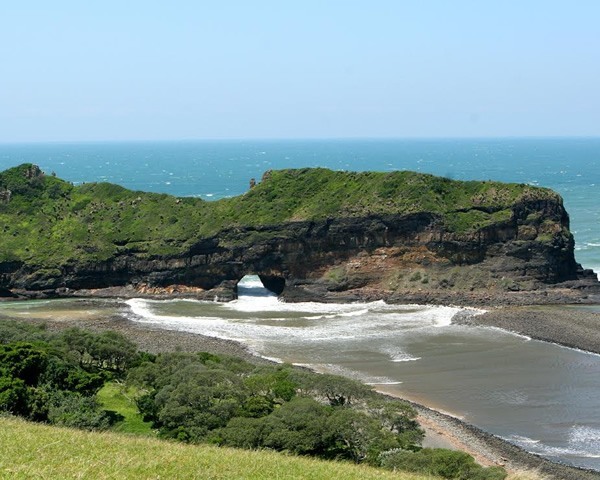
|
|
The natural rock formation “Hole-in-the-Wall” near Coffee Bay on the Wild Coast. ©Tanya Linnegar of Linnegar Photography.
|
Foremost on our itinerary during a recent trip to South Africa was a visit to Coffee Bay — one of the loveliest spots on the Wild Coast of the Eastern Cape — if not in the whole world. The Eastern Cape, with its 500-mile stretch of unspoiled coastline, is South Africa’s second-largest province and homeland to the Xhosa nation. There is no better way of getting to know these proud people with their ancient tribal culture than by visiting Coffee Bay.
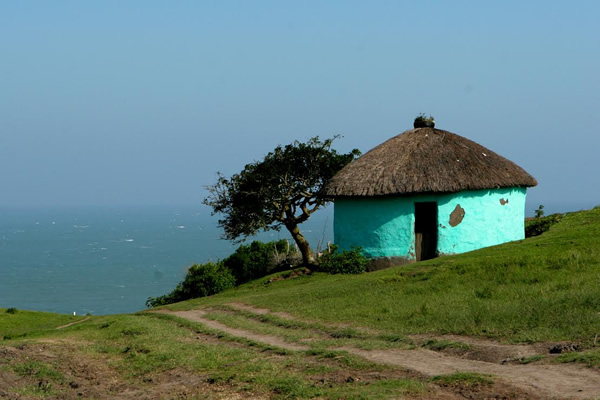
|
|
A traditional Xhosa hut overlooking the ocean on the Wild Coast near Coffee Bay. ©Tanya Linnegar of Linnegar Photography.
|
In East London, the nearest major airport to the Wild Coast, we rented a car and headed north-east on the N2 highway towards Mthatha. An essential stop en route was Qunu, where the Nelson Mandela Museum was opened in 2000 in the birthplace of the esteemed statesman who spent his early years in this peaceful village on the banks of the Qunu river.
The turn-off to Coffee Bay is just before Mthatha. From here, a good paved road winds its way eastward down to the coast. The pleasant drive takes about an hour, through tranquil rural scenery dotted with Xhosa huts, animals grazing in the fields and children gaily waving at passing motorists. A group of schoolchildren who crowded around our vehicle were delighted to be given some Mardi Gras beads we had brought along with us all the way from New Orleans!
Coffee Bay is a small community, which got its name in 1893 when a ship full of coffee beans ran aground here. Some of the beans did take root and grow, but the salty soil was not suitable for them to thrive in, so today there are no coffee plants to be seen in Coffee Bay!
The Ocean View Hotel more than lives up to its name with some spectacular sea views. Wild Coast hospitality is legendary and this family-run hotel is no exception. The rooms are light and airy, most are sea-facing. Meals are hearty, with freshly caught seafood a daily specialty. The hotel has a well-stocked craft shop crammed with Xhosa beadwork.
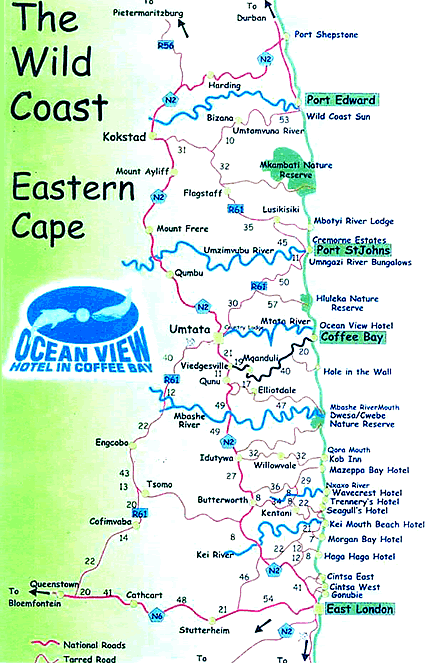
|
|
Map of the Wild Coast of South Africa. (courtesy of Ocean View Hotel, Coffee Bay).
|
Things to do here, apart from relaxing, taking deep ocean breaths and long walks on the sand, include every type of water sport and bird-watching. You may even choose something more active, like abseiling down a sheer cliff or going on a guided quad bike excursion. The hotel also arranges guided 4x4 trips to places of interest in the area.
In order to learn more about Xhosa tribal life, we hired a guide recommended by the hotel with whom we spent a day walking across the hills and dales of his homeland. Sipho, as he was introduced to us by the hotel receptionist, was a fresh-faced, smiling youth who spoke good English. He told us he was a High School student, now home on vacation. This informal “tour” was the highlight of our visit to Coffee Bay.
As the five of us set out on our hike among the goats and sheep, Sipho introduced us to the history of the Xhosa nation, a sector of the Nguni people who migrated from north-east Africa. The Wild Coast area was originally inhabited by the KhoiSan tribes and, due to the Xhosa’s interaction with them, the isiXhosa language spoken today still includes some of the distinctive “clicks” of the KhoiSan language.
Sipho told us about the Xhosa male initiation ceremony, a sacred rite of passage to manhood. Young initiates (abakwetha) go through the khwetha or circumcision school. Every year several initiates are hospitalized or die from infection of the wounds inflicted during ritual circumcision done under unhygienic conditions, traditionally with the tip of an assegai, during which the youth is not allowed to flinch. The traditional surgeon (ingcibi) performs the circumcision and a traditional attendant (ikhankatha) is appointed to attend to the boys after the ritual.
Initiates spend a period of seclusion in make-shift huts made of grass and leaves, during which time they smear their bodies with white clay and wear only a single blanket. When the wounds have healed, they emerge, the white clay is washed from their bodies and the grass huts burnt down, symbolizing a burning down of their past and an entry into manhood. Today, many young men are circumcised in hospitals, but these circumcisions are not highly regarded by the Xhosas.
We were led by our agile guide through spectacular scenery, surrounded by high cliffs and breathtaking ocean views, down into valleys and along muddy stream beds. Finally, our trail led into the village of the local sangoma (witchdoctor). Sipho introduced us to this grey-bearded gentleman seated on the ground inside his large, round, almost bare hut, its floor smeared with cow dung. We also met his smiling young wife and son. All the while, we were made to feel like welcome, honored guests. Although the sangoma and family only spoke isiXhosa, their words were interpreted for us into English by Sipho.
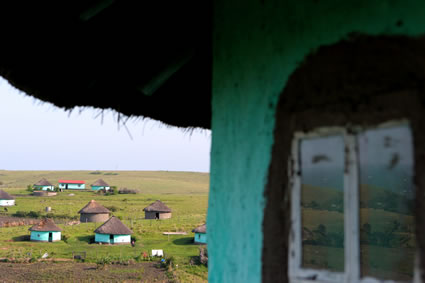
|
|
Looking across at the Xhosa village from the hut of the sangoma (witchdoctor) near Coffee Bay. ©Tanya Linnegar of Linnegar Photography.
|
Sipho explained that a sangoma — a practitioner of herbal medicine — is greatly respected by his tribe. Traditional medicine is based on a belief in ancestral spirits and is often the first choice above Western medicine. Xhosas have a strong belief in the supernatural, with an everyday fear of the evil influence of witches and evil spirits. Very important are their beliefs in sacrifice, respect and obedience to their elders.
Seated on the floor in front of the sangoma, we waited in silence for his words. We were each welcomed in turn to his home and given his blessing. He allowed us to take a few photographs. Then we all shook hands warmly as we left this strangely spiritual atmosphere and emerged into the bright sunlight to be surrounded by children and chickens.
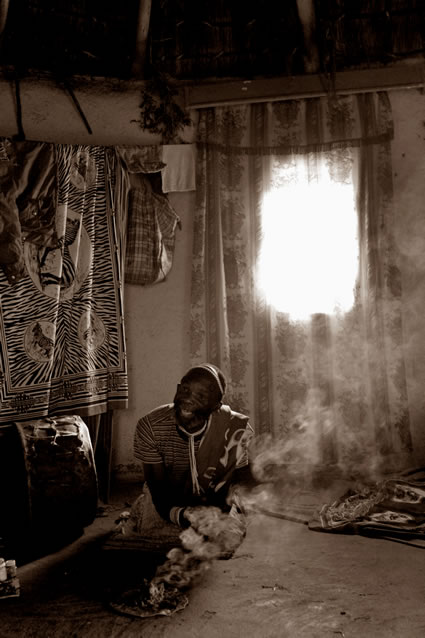
|
|
Inside his hut, the sangoma gives his blessing to the foreign visitors. ©Tanya Linnegar of Linnegar Photography.
|
Time has stood still in these tribal villages, untouched by Western man and his newfangled technology. However, we did sight a satellite TV dish on one mud hut! The huts, which are round and mud-walled with conical thatched roofs, are generally grouped around a cattle enclosure. The floor is made of cow dung or ant-heap soil which is tightly compressed.
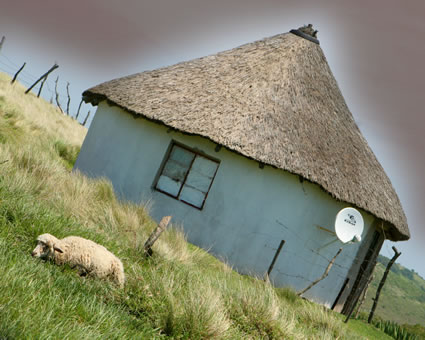
|
|
Western technology has arrived in this Xhosa tribal village! A traditional mud hut with satellite TV. ©Tanya Linnegar of Linnegar Photography.
|
Several families live in a group of huts and each household is headed by a husband, with the women strictly under his supervision. The position of head of the household is hereditary and passes to the first-born male, regardless of age.
When a woman marries, she falls under the control of the male hierarchy of her husband’s family. A married woman keeps her head covered at all times, a large headdress signifying someone worthy of respect. We passed an elderly woman smoking a long pipe. Sipho mentioned that a woman was only allowed to smoke a pipe after having borne children, the pipe stem being lengthened after each child.
A favorite Xhosa drink is umqqombothi, a beer made from corn, maize malt, sorghum, yeast and water. Corn is the staple diet, with some meat and vegetables also being eaten.
Polygamy is often practiced and a dowry of cattle (lobolo) is paid by the bridegroom to the bride’s family. Cattle, as a symbol of wealth, and goats as sacrificial animals play an important part in Xhosa culture. In traditional families, generations all live together, children caring for parents in their old age. Children are thus also regarded as symbols of wealth.
Our day with Sipho was an inspiring experience and it was with reluctance we bade him farewell. We had learned much about the country and its indigenous people from this unassuming young man.
On our last day, we went on a guided quad bike excursion and also visited the natural geological wonder, “Hole-in-the-Wall”, before spending the rest of the sunny day relaxing on Umdumbi Beach, said to be one of the best beaches in South Africa. The beach offers miles of golden sands, virtually undisturbed by the footprints of man.
To get to the heart of the Xhosa culture, to witness at first hand the intermingling of African and European cultures and to experience the goodwill inherent in this beautiful, multicultural land of South Africa, there can be no better place to begin with than Coffee Bay.
For More Info on Coffee Bay on the Wild Coast
How to Get to the Eastern Cape
For useful information about transporation within South Africa check out Lonely Planet's extensive tips for Travel in South Africa as well as the official South Africa Tourism website.
Approximate Daily Travel Costs Per Person
Food: About $25 per day.
Accommodations: $50 per person per night
(at the current rate of exchange at the time of writing).
Currency: Rands and cents. The present exchange rate is US$1 = R19.
Language: English is widely spoken. Among the rural Xhosa, only isiXhosa is spoken.
Some Useful isiXHOSA Phrases
|
ewe
|
yes
|
|
hayi
|
no
|
|
molo
|
hello / good day
|
|
kunjani?
|
how are you?
|
|
ndiphilile
|
I am fine
|
|
enkosi
|
thank you
|
|
nceda
|
please
|
|
uvela phi?
|
where have you come from?
|
|
sala kakuhle
|
goodbye / stay well
|
|
uhambe kakuhle
|
go well
|
|
hlala kakuhle
|
live well
|
|
Tanya Linnegar was born in Johannesburg, South Africa, spending her childhood in the
Eastern Cape city of East London. At the age of 4, she was given her first camera by her
stepfather and, while growing up in South Africa, was privileged to be able to explore the
field of wildlife and nature photography during many family vacations spent in the
National Parks of South Africa. After graduating from High School, Tanya began a college
degree course in Photography at the Port Elizabeth Technikon (now known as Nelson Mandela
Metropolitan University). She now lives in Vancouver, British Columbia, Canada where she
is finishing her Bachelor of Fine Arts degree (majoring in Photography) at the Emily Carr
University of Art and Design.
|
